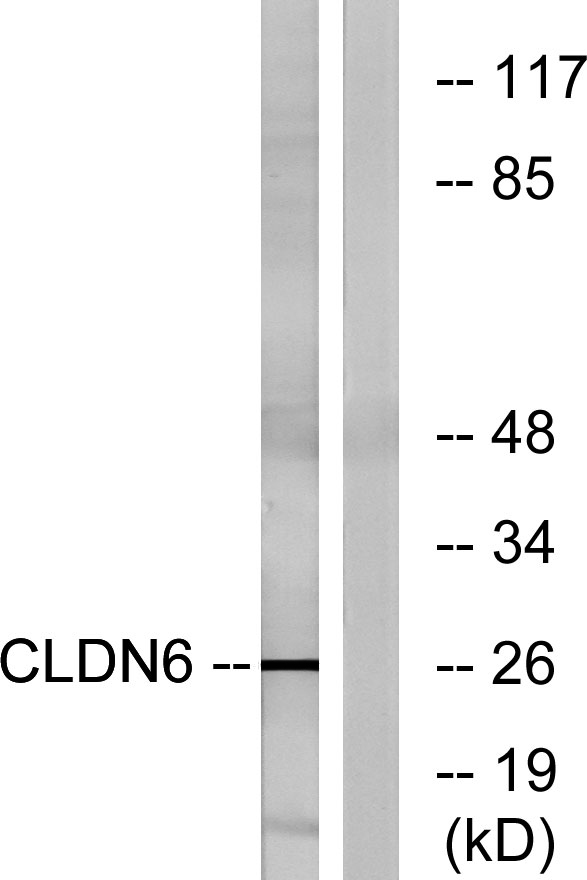Claudin-6 Polyclonal Antibody
- Catalog No.:YT0955
- Applications:WB;IHC;IF;ELISA
- Reactivity:Human;Mouse
- Target:
- Claudin-6
- Fields:
- >>Cell adhesion molecules;>>Tight junction;>>Leukocyte transendothelial migration;>>Pathogenic Escherichia coli infection;>>Hepatitis C
- Gene Name:
- CLDN6
- Protein Name:
- Claudin-6
- Human Gene Id:
- 9074
- Human Swiss Prot No:
- P56747
- Mouse Swiss Prot No:
- Q9Z262
- Immunogen:
- The antiserum was produced against synthesized peptide derived from human CLDN6. AA range:81-130
- Specificity:
- Claudin-6 Polyclonal Antibody detects endogenous levels of Claudin-6 protein.
- Formulation:
- Liquid in PBS containing 50% glycerol, 0.5% BSA and 0.02% sodium azide.
- Source:
- Polyclonal, Rabbit,IgG
- Dilution:
- WB 1:500 - 1:2000. IHC 1:100 - 1:300. IF 1:200 - 1:1000. ELISA: 1:40000. Not yet tested in other applications.
- Purification:
- The antibody was affinity-purified from rabbit antiserum by affinity-chromatography using epitope-specific immunogen.
- Concentration:
- 1 mg/ml
- Storage Stability:
- -15°C to -25°C/1 year(Do not lower than -25°C)
- Other Name:
- CLDN6;Claudin-6;Skullin
- Observed Band(KD):
- 26kD
- Background:
- Tight junctions represent one mode of cell-to-cell adhesion in epithelial or endothelial cell sheets, forming continuous seals around cells and serving as a physical barrier to prevent solutes and water from passing freely through the paracellular space. These junctions are comprised of sets of continuous networking strands in the outwardly facing cytoplasmic leaflet, with complementary grooves in the inwardly facing extracytoplasmic leaflet. This gene encodes a component of tight junction strands, which is a member of the claudin family. The protein is an integral membrane protein and is one of the entry cofactors for hepatitis C virus. The gene methylation may be involved in esophageal tumorigenesis. This gene is adjacent to another family member CLDN9 on chromosome 16.[provided by RefSeq, Aug 2010],
- Function:
- function:Plays a major role in tight junction-specific obliteration of the intercellular space.,similarity:Belongs to the claudin family.,subunit:Directly interacts with TJP1/ZO-1, TJP2/ZO-2 and TJP3/ZO-3.,
- Subcellular Location:
- Cell junction, tight junction . Cell membrane ; Multi-pass membrane protein .
- Expression:
- Expressed in the liver, in peripheral blood mononuclear cells and hepatocarcinoma cell lines.
Multi-functional platelet membrane-camouflaged nanoparticles reduce neuronal apoptosis and regulate microglial phenotype during ischemic injury Appl Mater Today. 2022 Jun;27:101412. WB Mouse,Rat
- June 19-2018
- WESTERN IMMUNOBLOTTING PROTOCOL
- June 19-2018
- IMMUNOHISTOCHEMISTRY-PARAFFIN PROTOCOL
- June 19-2018
- IMMUNOFLUORESCENCE PROTOCOL
- September 08-2020
- FLOW-CYTOMEYRT-PROTOCOL
- May 20-2022
- Cell-Based ELISA│解您多样本WB检测之困扰
- July 13-2018
- CELL-BASED-ELISA-PROTOCOL-FOR-ACETYL-PROTEIN
- July 13-2018
- CELL-BASED-ELISA-PROTOCOL-FOR-PHOSPHO-PROTEIN
- July 13-2018
- Antibody-FAQs
- Products Images

- Western Blot analysis of various cells using Claudin-6 Polyclonal Antibody

- Immunofluorescence analysis of HUVEC cells, using CLDN6 Antibody. The picture on the right is blocked with the synthesized peptide.

- Immunohistochemistry analysis of paraffin-embedded human ovary tissue, using CLDN6 Antibody. The picture on the right is blocked with the synthesized peptide.

- Western blot analysis of lysates from Jurkat cells, using CLDN6 Antibody. The lane on the right is blocked with the synthesized peptide.



